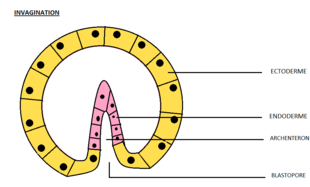
Back Invaginasie Afrikaans انغماد Arabic Invagination German Invaginación Spanish Invaxinación Galician Invaginatie (gastrulatie) Dutch Inwaginacja Polish Invaginação Portuguese Инвагинация (эмбриология) Russian Інвагінація Ukrainian

Invagination is the process of a surface folding in on itself to form a cavity, pouch or tube. In developmental biology, invagination is a mechanism that takes place during gastrulation. This mechanism or cell movement happens mostly in the vegetal pole. Invagination consists of the folding of an area of the exterior sheet of cells towards the inside of the blastula. In each organism, the complexity will be different depending on the number of cells. Invagination can be referenced as one of the steps of the establishment of the body plan.[1][2] The term, originally used in embryology, has been adopted in other disciplines as well.
There is more than one type of movement for invagination. Two common types are axial and orthogonal. The difference between the production of the tube formed in the cytoskeleton and extracellular matrix. Axial invagination can be formed at a single point along the axis of a surface. Orthogonal invagination is linear and trough.[3]
- ^ Gilbert, Scott; Rauno, Anne (1997). Embryology, Constructing the Organism. Sunderland, Massachusetts: Sinauer Associates. ISBN 0-87893-237-2.
- ^ Gilbert, Scott; Barresi, Michael (2016). Developmental Biology. Massachusetts: Sinauer Associates. ISBN 9781605354705.
- ^ Davies, Jamie A. (2013). Mechanisms of Morphogensis (2nd ed.).